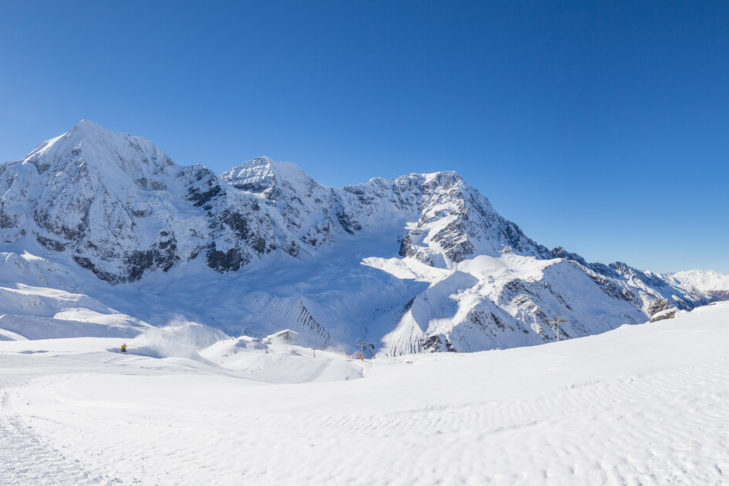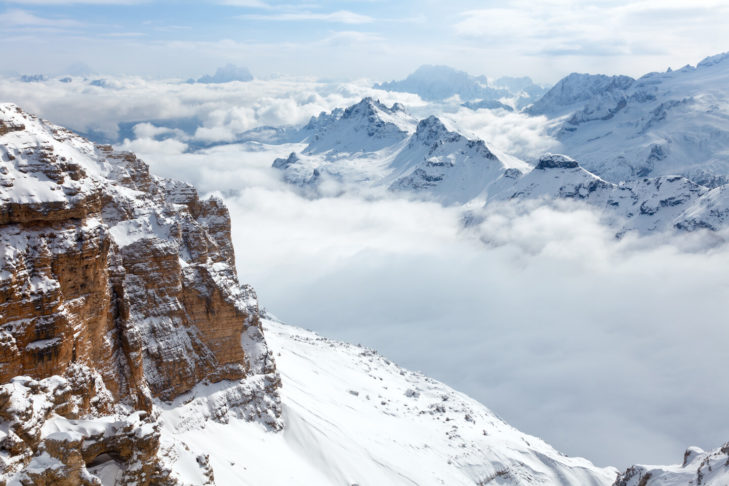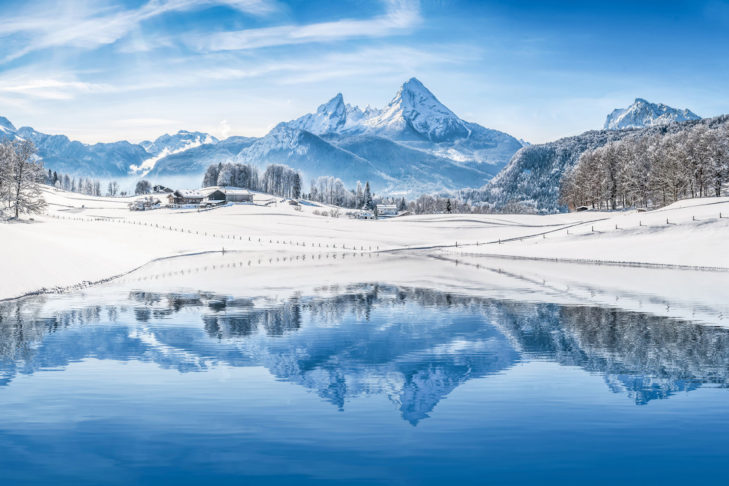Anyone travelling to the Alps in winter to carve turns in the snow on skis or a snowboard naturally wants to do so on perfectly groomed pistes in first-class ski resorts. And when the view from the slopes sweeps up to striking peaks, the heart of a winter sports enthusiast is happy. But where are the highest and most famous mountains in the Alps? SnowTrex explains and shows where skiers can best enjoy the view of the Matterhorn, Mont Blanc and co.
An overview of the most famous mountains in the Alps
| Mountain | Height | Country |
|---|---|---|
| Mont Blanc | 4,810 m | France |
| Dufourspitze | 4,634 m | Switzerland |
| Matterhorn | 4,478 m | Switzerland |
| Eiger-Mönch-Jungfrau triumvirate | 4,158 m | Switzerland |
| Ortler | 3,905 m | Italy |
| Großglockner | 3,798 m | Austria |
| Wildspitze | 3,768 m | Austria |
| Großvenediger | 3,657 m | Austria |
| Dolomites | 3,343 m | Italy |
| Kitzsteinhorn | 3,203 m | Austria |
| Sella Massif | 3,125 m | Italy |
| Dachstein | 2,995 m | Austria |
| Zugspitze | 2,962 m | Germany |
| Hochkönig | 2,941 m | Austria |
| Watzmann | 2,713 m | Germany |
Mont Blanc in France (4,810 m)
Of course, the highest peak in Europe should not be missing from the top mountains in the Alps. The majestic Mont Blanc measures 4,810 metres. The mountain itself lies in the Mont Blanc group of the same name on the border between France and Italy. Its imposing appearance also forms the unique backdrop to the Chamonix-Mont Blanc ski region. In the ski areas around the French colossus, which is also known as the “Roof of the Alps”, winter sports enthusiasts will find a total of 870 kilometres of pistes and around 260 lifts. The world-famous Mont Blanc itself is not accessible on skis or snowboards. This is one of the reasons why the initiative to make the mountain massif a UNESCO World Heritage Site was launched in 2017 due to its unspoilt nature.
Dufourspitze in Switzerland (4,634 m)
The highest mountain in Switzerland is not, as many believe, the Matterhorn, but the Dufourspitze. However, this is not without dispute. At 4,634 metres, one of the highest Alpine peaks towers above all of the country’s four-thousand-metre peaks, but it is also around 160 metres as the crow flies from the Italian border and therefore largely outside of Switzerland. However, what is undisputed is that the Dufourspitze is the second highest mountain in the Alps after Mont Blanc. It is part of the Monte Rosa massif in the Valais Alps. Incidentally, the imposing rock formation is named after the Swiss general and cartographer Guillaume-Henri Dufour, who published the first accurate map of Switzerland in the mid-19th century.
Skiing on groomed pistes is not possible on the flanks of the Dufourspitze itself. Instead, the mountain is a paradise for ski tourers, who repeatedly set off from the legendary Monte Rosa hut at 2,883 metres to one of the most famous peaks in the Alps. A breathtaking view of the valleys of Italy and the numerous four-thousand-metre peaks of the Valais Alps awaits them there.
Matterhorn in Switzerland (4,478 m)
The Matterhorn – one of, if not the symbol of Switzerland – is undoubtedly one of the most famous mountains in the Alps and, at 4,478 metres, also one of the highest peaks in the Swiss Confederation. The mighty rock with its striking peak lies in the Valais Alps between Breuil-Cervinia and Zermatt. A special feature of the Matterhorn, which cannot be climbed on skis or snowboards, is that the east, north and west faces are on Swiss territory and the south face on Italian territory. The Zermatt ski area is located within easy sight of the famous mountain, which winter sports enthusiasts always have in view on most of the 200 kilometres of pistes.
Swiss climber Dani Arnold set a world record by scaling the north face of the Matterhorn:
Please also note that by using our services and integrating the YouTube API Services, the YouTube Terms of Service and the YouTube API Services Terms apply and your use of our website is deemed to be acceptance of these terms.
Eiger, Mönch & Jungfrau in Switzerland (up to 4,158 m)
In the Bernese Alps, the famous ‘triumvirate’ of Jungfrau (4,158 m), Mönch (4,107 m) and the Eiger (3,970 m) with its world-famous north face cannot be overlooked. The trio of peaks lies on the border between the Swiss cantons of Bern and Valais. At 4,158 metres, the Jungfrau is the highest mountain in the triumvirate and part of the 820 km² Jungfrau-Aletsch region in the Swiss Alps, which has been declared a UNESCO World Heritage Site. Skiers and snowboarders also get their money’s worth here within sight of the Eiger, Mönch and Jungfrau. After all, the Jungfrau Region boasts around 200 kilometres of pistes at altitudes ranging from 796 m to 2,970 m.
Ortler in Italy (3,905 m)
The highest mountain in South Tyrol is the 3,905 metre-high Ortler. The heavily glaciated mountain is located in the west of South Tyrol and is the main peak of the Ortler group of the same name. Numerous legends and myths surround the Italian giant. In the often gloomy tales, however, the Ortler is not only described as a fair-weather excursion destination. The mountain is not accessible to skiers and snowboarders, but is very popular with ambitious mountaineers. The first ascent of the summit was made by Archduke Johann of Austria in 1804. Ski fans will also get their money’s worth in the nearby ski area of Sulden am Ortler. In addition to a popular snow park, there are a total of 44 kilometres of pistes to explore here, from which a view of Italy’s most famous mountain is always worthwhile.
Großglockner in Austria (3,798 m)
The legendary Grossglockner is located in the Hohe Tauern in Austria and is the highest mountain in the country at 3,798 metres. The summit and the entire national park region, which is considered the cradle of alpinism, are also known today for their excellent winter sports conditions. The Großglockner itself is not accessible on skis or snowboards. However, snow lovers have the opportunity to explore the diverse ski area of Großglockner-Heiligenblut with its 55 kilometres of pistes and 13 lifts up to an altitude of 2,989 metres. The view of the Austrian giant makes skiing here a very special experience.
Wildspitze in Austria (approx. 3,768 m)
At 3,768 metres, the Wildspitze is the second highest mountain in Austria. The western and northern flanks of the three-thousander form the head of the Pitztal valley, while the southern and eastern sides end in the Venter Tal valley. Since 1933, the highest point of the Wildspitze has been adorned with a traditional summit cross, which was finally replaced by a new one in 2000. For mountaineers, the Wildspitze is a popular climbing area all year round, while skiers and snowboarders can head to the Vent ski area and enjoy the view of the mountain from there. The slopes, however, are along the lines of “small but mighty”, as the ski area impresses with 5 km of blue and 10 kilometres of red pistes and, thanks to its altitude of between 1,900 m and 2,646 m, also offers a high level of snow reliability. This makes the ski area particularly suitable for families, as children will also find their way around the manageable area.
Großvenediger in Austria (3,657 m)
At 3,657 metres, the Großvenediger is the highest mountain in the Venediger group in the Austrian province of Salzburg. The summit area is heavily glaciated and has become famous for its impressive appearance with four striking ridges. The ‘World’s Old Majesty’, as the mountain has been known since its first ascent in 1841, has continued to lose height in recent years due to the progressive melting of the glaciers. In the 1980s, the summit stood at 3,674 metres. Winter sports enthusiasts will search in vain for groomed pistes on the Großvenediger, although the alpinist Günther Freiherr von Saar set a milestone in 1902 when he reached the summit on skis. Today, however, skiing on the Salzburg glacier is reserved for the absolute elite of the freeriding scene. A fantastic ‘alternative’ for skiers and snowboarders is the Wildkogel-Arena, where a total of 75 kilometres of pistes await and the panorama of the Hohe Tauern and the fantastic view of the thousand-year-old majesty are omnipresent.
Dolomites in Italy (up to 3,343 m)
The northern Italian mountain range is undoubtedly one of the most popular, best-known and, above all, most beautiful mountain regions in the Alps, if not the world! The Dolomites are part of the Southern Alps, where the impressive rock formations are spread across the regions of Veneto and Trentino-Alto Adige. In total, there are over 60 three-thousand metre peaks in the Dolomites, with the Marmolada at Punta Penia being the highest mountain group in the region at up to 3,343 metres, which is why it is also known as the ‘Queen of the Dolomites’. And because the grey limestone reminds many locals of marble due to its light colour, it also gives the imposing ‘Marmolada’ its name.
In addition to nature lovers, winter sports enthusiasts can of course also explore the Dolomites UNESCO World Heritage Site. Skiers and snowboarders will find a true paradise here, as the entire Dolomiti Superski ski region offers an incredible 1,200 kilometres of pistes with guaranteed snow between 1,500 and 3,200 metres above sea level, 450 lifts, 400 ski huts at the edge of the slopes, 24 snow parks and, last but not least, a panorama in a class of its own with unique peaks such as the Three Peaks (2,999 m).
Kitzsteinhorn in Austria (3,203 m)
The Kitzsteinhorn with its glacier lies within sight of Kaprun in Salzburger Land. Just 200 metres below the 3,203-metre-high summit is the mountain station of the Gipfelbahn, which is part of the Kitzsteinhorn/Maiskogel-Kaprun ski area. In the ski area, fun on the slopes is guaranteed on a total of 138 kilometres of pistes, which are served by 47 lifts! The three sub-ski areas on the Kitzsteinhorn glacier, the Maiskogel and the Schmittenhöhe offer everything a winter sports enthusiast could wish for. Beginners can practise their first turns on wide, flat slopes, while advanced and ambitious carvers glide down into the valley on red and black pistes. All three also have their own fun park with various obstacles such as rails, tubes and boxes as well as kickers in different sizes.
Sella Massif in Italy (3,125 m)
The Sella massif is a plateau-shaped mountain range in the Italian Dolomites, which is known to many winter sports enthusiasts primarily as a ski resort. The mountain formation is partly located in South Tyrol, Trentino and Veneto, with the highest peak of the Sella being Piz Boè (3,125 metres). However, skiers and snowboarders rarely get to see it, as the region is mainly known for the “most beautiful round tour in Italy”, the Sellaronda. On what is probably the most famous ski circuit in the world, fitness is required, as winter sports enthusiasts need at least six hours to complete the 40 kilometres of pistes, even at a brisk pace. On the ski circuit, which can be travelled clockwise or anti-clockwise, winter sports enthusiasts cross four valleys in three provinces and, as all the runs are blue or red pistes, the Sellaronda is not only suitable for professionals.
Dachstein in Austria (2,995 m)
As the name suggests, the Dachstein is the highest mountain in the Dachstein massif. Due to its so-called double summit, the mountain is also known far beyond the borders of the Alpine republic. The higher of the two peaks also bears the name Dachstein and lies at an altitude of 2,995 metres. Just 400 metres to the north is the Lower Dachstein at 2,934 metres. The pistes around Ramsau and Schladming are part of the large Ski amadé ski region . A total of 760 kilometres of pistes await here, including 30 kilometres of pistes on and around the Dachstein glacier. Away from the pistes, freeriders can let off steam on 43 kilometres of ski routes.
Zugspitze in Germany (2,962 m)
Germany is not necessarily the country that is first associated with dreamy winter landscapes and spectacular Alpine mountain panoramas. And yet one of Germany’s peaks should not be missing from the list of the most famous mountains in the Alps: the Zugspitze. Germany’s highest mountain is located in the Wetterstein mountain range not far from Garmisch-Partenkirchen and reaches an altitude of 2,962 metres. The popular Garmisch-Classic, Zugspitze ski area primarily attracts skiers and snowboarders in winter with 60 kilometres of perfectly groomed pistes, including the legendary Kandahar descent. The Zugspitze cable car, which was renovated in 2017, takes you up the mountain and offers breathtaking views of the Bavarian Alps through its floor-to-ceiling windows. The mountain station is located at an altitude of 2,943 metres, just 20 metres below the summit of the highest German mountain and one of the most photogenic mountains in the Alps.
Hochkönig in Austria (2,941 m)
As one of the most majestic and imposing mountains in Austria, the Hochkönig rightly bears its name. Although the peak is “only” 2,941 m high, it is characterised by a special feature in the Berchtesgaden Alps. This is because the Hochkönig towers above all the peaks within a radius of 35 kilometres. This is another reason why the region with its striking mountain massif is so popular with alpine winter sports enthusiasts. The Hochkönig ski area alone boasts 120 kilometres of pistes and 36 lifts. With its wide range of flat and wide pistes, it is particularly suitable for families and beginners.
Watzmann in Germany (2,713 m)
In the south of Germany, in Bavaria to be precise, lies the imposing Watzmann with an altitude of 2,713 metres. However, the mountain is not famous for its height, but for its extraordinary and majestic shape. The Watzmann, which is also known as the ‘mountain of destiny of the Berchtesgaden region’, has won the title of the most beautiful mountain in the world in surveys conducted by specialist magazines in the past, even beating world-famous peaks such as the Matterhorn or the Eiger. The east face of the Watzmann alone stretches over 1,800 metres in altitude, making it the longest rock face in the Eastern Alps. In winter, skiers and snowboarders in the Berchtesgaden ski region have a total of 44 kilometres of pistes in the most beautiful Alpine landscapes at their disposal.
FAQ’s on famous mountains in the Alps
What makes Mont Blanc such a special winter sports destination?
Mont Blanc, the highest mountain in Europe at 4,810 metres, provides an impressive backdrop for the Chamonix-Mont Blanc ski region. While the mountain itself is not skiable, the region offers around 870 kilometres of pistes and 260 lifts, making it a dream destination for skiers and snowboarders.
Is the Dufourspitze in Switzerland suitable for ski tours?
Yes, the Dufourspitze, the second highest mountain in the Alps at 4,634 metres, is an ideal destination for ski tourers. While skiing on groomed pistes is not possible here, the legendary Monte Rosa hut (2,883 m altitude) is the perfect one of several unique ski routes, offering winter sports enthusiasts some of the best Alpine views of the Italian valleys and the surrounding four-thousand-metre peaks.
What can winter sports enthusiasts expect in the Matterhorn ski area?
Das Skigebiet Zermatt in der Nähe des ikonischen Matterhorns (4.478 m) bietet Wintersportlern über 200 Pistenkilometer. Der Berg selbst kann zwar nicht befahren werden, aber seine einzigartige Silhouette ist von fast überall im Skigebiet sichtbar und sorgt für ein unvergessliches Erlebnis.
What are the highlights of the Jungfrau Region in Switzerland for skiers and snowboarders?
The Jungfrau region in Switzerland is known for its three impressive peaks: Eiger (4,158 m), Mönch (4,107 m) and Jungfrau (4,158 m). Skiers and snowboarders can let off steam here on around 200 kilometres of pistes between 796 m and 2,970 m elevation. With its impressive glacier world, the region is also part of the UNESCO World Heritage Site and always offers spectacular views of the eternal ice.
What does the Dolomiti Superski ski area in the Italian Dolomites have to offer?
Dolomiti Superski is one of the largest ski regions in the world and comprises 1,200 kilometres of slopes at an altitude of between 1,500 and 3,200 metres. Skiers and snowboarders will find 450 lifts, almost 400 ski huts, 24 snow parks and a breathtaking panorama in the ski areas here. A particularly well-known peak in the region, which was declared a UNESCO World Heritage Site in 2009, is the Drei Zinnen (Three Peaks) (2,999 m), which help to characterise the panorama of the Dolomites with their striking rocky peaks.
















